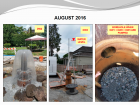
Features
Drilling
Flowing artesian wells: Regulations, risk, reality
May 1, 2018 By Carolyn Camilleri
By now, everyone in the industry probably knows this story, but just in case. In September 2015, in West Vancouver’s expensive, densely urban Kerrisdale neighbourhood, a homeowner contracted a homebuilder who contracted a drilling company to install a geothermal heating system.
The drillers encountered a high-pressure aquifer at very shallow depths and weren’t able to re-achieve control before it became catastrophic. An estimated two million litres of fresh water a day flowed out of that borehole. In May 2017, the Vancouver Sun put the cost at $10 million dollars, and at that point, the water was still flowing.
Thierry Carriou and Richard Cronin of BC Groundwater Consulting Services Ltd. know all about that story, because they were called in to get it under control and closed, which they did.
Carriou is a professional engineer with 25 years of experience as a consultant, crew foreman, engineer and superintendent. Cronin, who got his start working with his father in Ontario’s Keswick-Sutton area, has been in the industry for 35 years, including 20 years in flowing well control and grouting in B.C., Alberta and Manitoba.
Carriou points out that the Kerrisdale situation was rare only because it occurred in a densely populated residential area. Because of the older storm drain infrastructure, which is connected to the sanitary system, twin eight-inch overland pipelines had to be constructed to carry the water a kilometre away to the main storm drain. Surrounding homes were on evacuation alert, and there were concerns about sewage backup and million-dollar homes dropping into sinkholes.
But flowing artesian conditions are quite common.
“Probably a full third of well construction that we supervise is some version of artesian,” Carriou says.
Another example of an out-of-control well, perhaps less spectacular in location, but also a nightmare: in rural B.C., a driller hit 750 gallons a minute at about 12 psi, which continues flowing to this day.
“There was no record of any artesian flows in that area either,” says Cronin, adding that, in fact, two other wells had been drilled nearby – one a stone’s throw away and another to the north – and they didn’t flow.
“The driller naturally assumed, ‘Well, I’m in good shape,’ ” Cronin says. “But this happened. These types of wells always seem to happen in the most terrible places. This well was drilled probably 30, 40 feet from a provincial highway. Now, it’s snowballed with the Ministry of Transportation involved, because they’re worried about erosion of their highway.”
It really can happen to anyone and not only water well drillers: “Any type of driller, whether it be geo, technical, environmental, or whomever, can run into these situations,” Cronin says.
Getting that message across was a focus in “Flowing Artesian Wells: Experience with Control and Closure in British Columbia,” a seminar Carriou and Cronin jointly presented at the National Ground Water Association conference in Nashville last December. While the risk is something drillers everywhere need to consider, it is a particularly hot topic in B.C.
Under B.C.’s new Water Sustainability Act and Groundwater Protection Regulation 2016, drillers are personally responsible if a flowing well goes out of control.
“Originally, the homeowner or the landowner was responsible, and then it would go down from there to the driller and if there was a professional involved,” Cronin says. “Now [with the new Water Sustainability Act in B.C.], that’s kind of reversed: if there’s a professional involved, he’s at the top of the responsibility ladder, and then there’s the driller and then the homeowner.”
Craig Stainton, executive director for the Ontario Ground Water Association, provides an Ontario perspective: “Responsibility basically boils down to who pays the additional costs, be it beforehand or in response to a flowing situation. The driller is responsible in Ontario, as well, unless they have a contract with the well/land owner absolving them of the additional costs of dealing with a flowing well. They are, however, still responsible.”
Personal responsibility is a heavy burden for an individual driller, especially when there are issues of interpretation within the regulations and questions about the experience and understanding of the people writing the regulations.
“One of the biggest issues is regulation,” Stainton says. “When one considers ¬ with a view to Ontario – with a well and pumping system, to get the water under pressure in a house and useable, as in coming out of a showerhead or flushing a toilet and certified potable for human consumption, there is more than one ministry involved and none seem to be on the same page. Or, in fact, often in the same room. It is the proverbial ‘dog’s breakfast.’ ”
While Carriou says he hopes and expects that eventually the regulations and responsibilities will become clearer, there is another reason drillers need to be more proactive about risks involved with flowing artesian conditions: you might get sued.
The geothermal drillers at the Kerrisdale project didn’t have the experience to deal with the situation – which they made worse by pulling their casing out – but they knew they were in trouble.
“They didn’t leave their casing, but they did leave the country,” Cronin says. “Within a few days they were gone. Completely gone. They’re a big company back in Italy, and they’re not fools. You see a certain condition arising, you have to make a decision.”
Cronin explains that, in the past, drillers were out of the public eye: “It’s great to be out in the middle of a field. You got the wind blowing in your hair. You’re alone. You’re independent. But we’ve become a litigious society now. Water, as we all know, is in the forefront.”
Carriou adds: “A lot of people like to blame the regulations, but it’s not just that. The regulations is a piece of it, but I would say, it kind of reinforces, just generally, where we are right now society-wise.”
PROTECTING YOURSELF
So how do you protect yourself? The message from Carriou and Cronin is clear: Do your homework. Don’t cut corners. Uncontrolled flow can lead to bankruptcy.
In other words: build better wells.
Stainton fully agrees: “If every well is constructed in such a manner that a flow could be controlled, then better wells will abound.”
“I know a lot of drillers do not like it, but I see it as a way of reinforcing research on where you are drilling prior to starting and providing good-quality construction,” Stainton says. “I have had drillers argue with me that they didn’t or don’t know if a well would flow, but when you get right down to it, if the well is constructed right from jump street to accommodate control in a flowing situation, in my opinion, it is going to be a better well.”
And it’s about being prepared, Cronin says.
“That’s my big thing. I’m big on logistics that way,” Cronin says. “Have the equipment on site if, in fact, something does happen, because – and this is part of the issue – it could’ve happened to anybody [referring to Kerrisdale]. You’ve got be knowledgeable and prepared and able to handle it.”
Stainton concurs, saying that, in Ontario, most people know where the flowing wells are, but there are some surprises, “And it should only be a surprise for a few minutes.”
Another sign of changing times is whom you need on your team. Carriou and Stainton both comment that drillers need to work together with consultants and lawyers. And they emphasize the need for a team approach, with both sides ¬ professional/education and field/direct experience – working in conjunction.
“It’s a structural issue because both sides are kind of entrenched,” Carriou says. “That’s the part that is going to take a long time to change. I also don’t think you can ram things down somebody’s throat.”
The team approach is clear in the advice Carriou and Cronin offered at the Nashville seminar:
“Every situation is unique. Expect the unexpected. Seek external assistance and advice (contractor, professional, legal). Team up with a qualified, experienced hydrogeologist or engineer with a proven track record and insurance. Consider specialty contractor services. If engaging a professional, ensure they accept the role of preparing the instructions in consultation with a driller. Also, assign them the role of ensuring all work is carried out in accordance with the regulations in your area.”
The elephant in the room is that all of this costs money.
“[Drillers] may have to construct a water well under artesian well control standards, and obviously, when you do that, it costs more money,” Cronin says.
Cost can make it a hard sell for drilling contractors, and Cronin understands that: “I’m fully aware of the challenges drillers have because they want to work. They’ve got mouths to feed. They’ve got to make payments on their rigs, and I get that. We all want to appease our customers. Do the best for them.”
Cronin also knows customers can be very persuasive when it comes to negotiating a price, even if it means cutting a few corners. He likens it to asking a dentist to leave out the freezing as a cost savings. Stainton echoes that line of thinking: “You wouldn’t ask a gasfitter or an electrician to cut corners: why are drillers asked or expected to cut corners?”
RISK, SAFETY AND REPUTATION
Ultimately, it is about risk, safety and reputation.
“Why would you be taking on your client’s risk if there’s a potential for artesian? Why would you be directing the client to not take safety precautions or not do the safety precautions on your own?” Carriou says. “Then a problem happens, and you’re now completely wearing it.”
Stainton agrees that the cost of mitigating risk needs to be part of the overall cost of the well.
“The client/customer should have to pay for those additional costs, and I have a fundamental problem with drillers who discount their prices and services,” Stainton says.
Cronin echoes this: “Drilling contractors and people in the industry have to value their services a little bit better. I think that’s a key thing.”
Another point Carriou and Cronin are strong on is that flowing artesian wells are not only naturally occurring, they are also tremendous assets.
Carriou offers an example: “We just did a project last week where we drilled a new well. I had a very strong suspicion, based on a bit of science and a gut feeling and some other things, that there was a pretty darn good chance that the well’s going to end up being artesian. We put it to this commercial client: I said to them, ‘You know what? We want to do a Halliburton-style seal. Is it being proactive? Absolutely. Is it going to cost an extra day, maybe a day and a half of time to do it? Yup. Absolutely.’ ”
“If you do have an artesian well, I think it’s important as an industry that we leave our clients with an asset rather than a liability,” Carriou says. “People are starting to get that.”
They’re also starting to get that the risks of not being prepared for a flowing artesian conditions are higher than they used to be.
“Take precautions,” Carriou says. “It might end up saving – well, a few thousand dollars for sure – but it might also end up saving your business.”
SIDEBAR: EXPERT TIPS
· Artesian conditions are a regular and natural occurrence. Consider each situation unique.
· Employ best practices and reliable advice.
· Drill that surface casing a little bit deeper and use a larger annular space if that makes sense.
· Don’t cut any corners. The cost of dealing with a problematic or out-of-control artesian well will eclipse any potential costs savings.
· Be careful of blindly following other people’s advice… they will likely not be around if the plan doesn’t pan out.
· Have confidence in your approach and remain steadfast. Rely on your intuition.
Source: Thierry Carriou and Richard Cronin. Flowing Artesian Wells Experience with Control and Closure in British Columbia. Seminar delivered at National Ground Water Association conference in Nashville in December 2017.
REFERENCE TOOLS
Flowing Artesian Wells: Water Stewardship Information Series includes clear, comprehensive explanations and guidelines for well drillers, consultants, and well owners. A PDF booklet is available for download at http://www.env.gov.bc.ca/wsd/plan_protect_sustain/groundwater/flowing_artesian_wells.pdf
The Government of Ontario’s website has a chapter called “Flowing Wells” that addresses guidelines and best practices and includes a statement of responsibility based on Ontario’s regulations. “If a well becomes a flowing well during well construction (including installing a pump and any alterations), the well contractor is responsible for the cost of complying with the flowing well construction or abandonment requirements in the Wells Regulation… The only exception is if there is a written contract between the well contractor and well purchaser that specifically releases the well contractor from these costs.”
Carolyn Camilleri is a Toronto-based writer, editor, and content strategist. She has been writing for consumer and trade magazines, as well as businesses and organizations, for more than 15 years.
Print this page


